Understanding Refractometers in Liquid Analysis
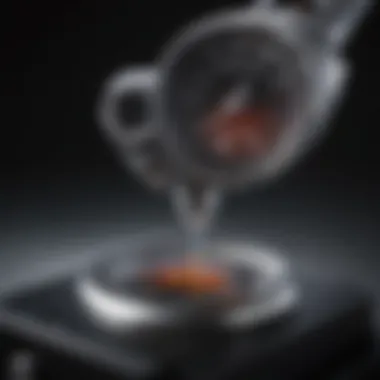
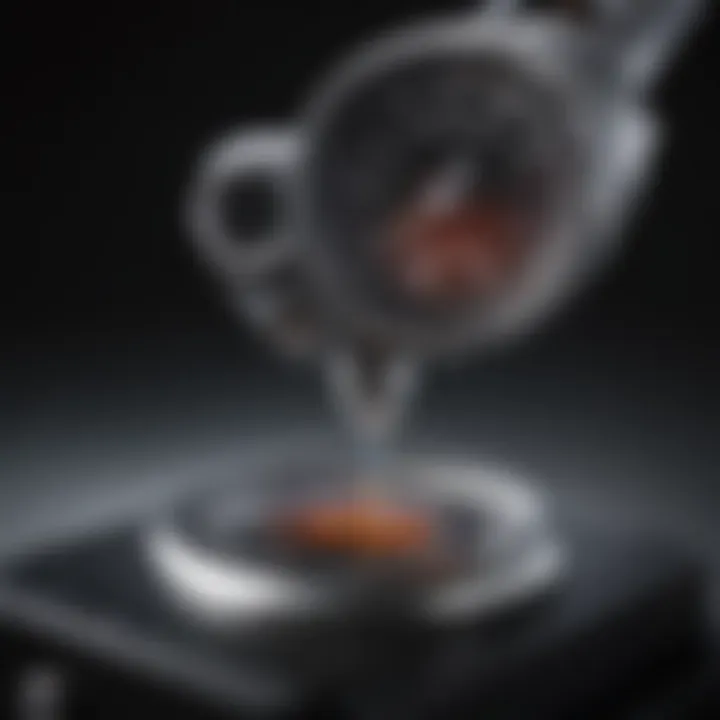
Intro
Refractometers play a crucial role in the analysis of liquids across a spectrum of industries. By measuring the refractive index, which is the degree to which light is bent when passing through a liquid, these instruments serve functions that are both practical and scientific. Understanding the way a refractometer works is not just an academic endeavor; it has real-world implications in areas like food safety, quality control in beverages, and precise gemology.
This article sets out to explore the many facets of refractometers, shedding light on their significance and applications while discussing the principles that underpin their operation. With a close look at historical perspectives and modern uses, both enthusiasts and professionals will find valuable insights and practical advice to enrich their understanding of liquid analysis.
The Basis of Refractometry
At its core, refractometry hinges on a fundamental optical principle, the refraction of light. The amount of bending that occurs depends on the liquid's composition. For instance, pure water has a refractive index around 1.33, while substances like syrup will have a higher index due to their density and sugar content. Refractometers detect this index with precision, allowing users to deduce various properties of the liquid.
Applications in Different Industries
Refractometers are employed in various sectors:
- Food and Beverage Industry: Ensuring that products such as juices and honey maintain their intended flavor and consistency.
- Pharmaceuticals: Assuring the quality of active ingredients by determining their concentrations.
- Gemology: Analyzing gemstones to identify authenticity and classification.
"With the right refractometer, one can unlock the secrets held within a drop of liquid."
Types of Refractometers
Refractometers come in different styles, each tailored for specific needs:
- Analytical Refractometers: Common in laboratories for precise measurements.
- Handheld Refractometers: Ideal for quick checks in field conditions, particularly valued by jewelers.
- Digital Refractometers: Offering enhanced accuracy, digital models provide clear readings with ease.
It’s essential to select a model that fits your intended use, ensuring that you get the best performance possible.
Factors Influencing Accuracy
When it comes to using a refractometer, understanding the factors that can impact accuracy is critical:
- Temperature: The refractive index changes with temperature, so an accurate measurement often requires temperature correction.
- Calibration: Regular calibration is necessary to maintain reliability in readings.
- Contamination: Even a minor impurity can skew results.
Maintenance of Refractometers
To keep a refractometer functioning properly, routine maintenance should not be overlooked. This involves:
- Cleaning the prism with a soft cloth after each use.
- Storing in a protective case to prevent damage.
- Regularly checking calibration against known standards.
These steps can significantly extend the life of the instrument, ensuring it remains accurate and reliable throughout its use.
Ending
Refractometers are indispensable tools for those engaged in liquid analysis. Their ability to measure the refractive index has far-reaching effects across a range of industries, from food safety and pharmaceuticals to gemology. By understanding their functionality, types, applications, and the importance of maintenance, both professionals and enthusiasts can harness the full potential of these devices. As we peel back the layers of refractometry, the significance of precision in liquid analysis becomes ever more apparent.
Prelude to Refractometers
In our quest to understand the materials that shape our world, refractometers emerge as essential tools, illuminating the path for gemologists, brewers, and food technologists alike. You might think of them as unsung heroes in the realm of liquid analysis. They bring precision to the table, quite literally. The refractive index measured by these devices not only defines the purity or concentration of a substance but can also affect a product's aesthetic appeal and overall quality.
Refractometers serve diverse industries, making them valuable assets. By knowing how to interpret the data they yield, professionals can ensure quality control at every stage. Whether pinpointing sugar levels in your favorite beverage or discerning the type of gemstone in your prized collection, a refractometer is often the go-to instrument. Their capacity to provide quick results can greatly impact decision-making processes, leading to efficient production and reduced waste.
Definition of a Refractometer
A refractometer is a scientific instrument that measures the refractive index of a liquid. In simpler terms, it assesses how light travels through a substance. When light enters a medium, it changes speed, which alters its direction. This shift is what we refer to as refraction. The ability to accurately measure this change is vital for multiple applications.
The refractive index found through a refractometer helps in understanding various properties of liquids, including concentration and purity. Imagine standing at a busy intersection, where cars slow down or speed up as the traffic light switches; that’s somewhat like how light behaves when entering a new medium. By utilizing a refractometer, scientists and professionals can translate this behavior into useful data.
History of Refractometry
The history of refractometry is as fascinating as the energy it captures. This journey dates back to the early 19th century when scientists first began harnessing the principle of light's bending properties. The invention of the first practical refractometer is attributed to Ernest Abbe in 1869, which laid down the groundwork for modern refractometry.
From those early days, refractometers have evolved significantly. Initially, mostly used in laboratories and scientific research, their applications quickly found places in industries like gemology and winemaking. As technology burgeoned, platforms for measuring refractive index transformed from rudimentary glass prisms to sophisticated digital devices. Today, refractometers come in various forms, each tailored for specific tasks and varying degrees of precision.
The ability to measure changes in light now supports tasks ranging from monitoring beverage quality to classifying gemstones, enriching lives and industries alike. It is remarkable to see how these devices have woven themselves into the fabric of multiple sectors, enhancing our understanding and interactions with materials.
Principles of Refraction
The principles of refraction play a fundamental role in the functionality of refractometers—essential instruments used to gauge the refractive index of liquids. By understanding how light interacts with different substances, we can derive critical insights into their composition and characteristics. This section aims to highlight the significance of these principles, particularly in diverse applications like gemology and food processing.
Understanding the Refractive Index
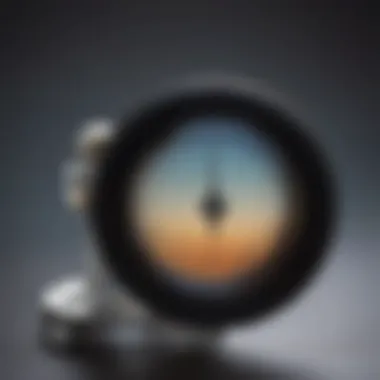
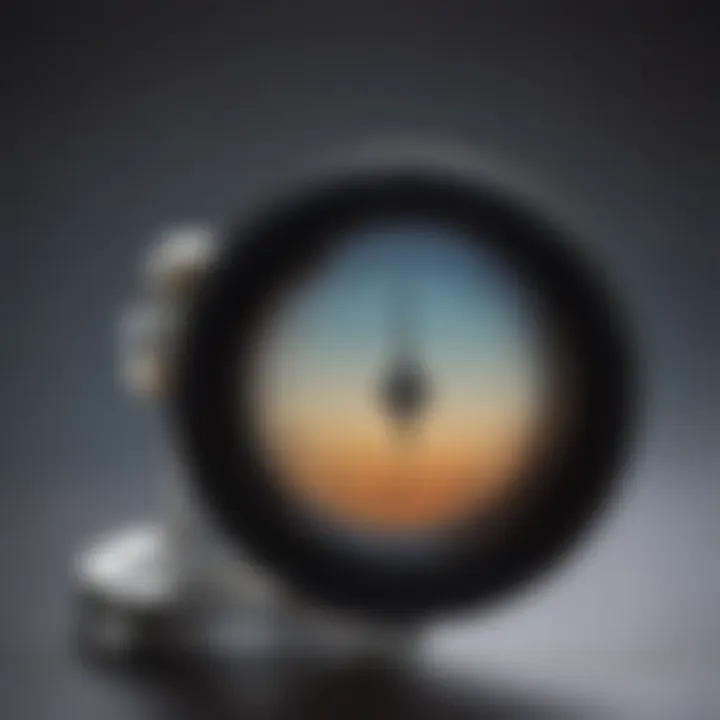
At the heart of refractometry lies the refractive index, a dimensionless number that illustrates how much light bends, or refracts, as it transitions from one medium to another. It's like trying to sneak a peek at a friend's garden through a window; depending on whether the glass is clear or frosted, your view can significantly differ. The refractive index indicates how fast light travels in a medium compared to a vacuum, where light travels at its maximum speed.
In mathematical terms, the refractive index (n) is defined as follows:
[ n = \fraccv ]\
Where:
- c is the speed of light in vacuum.
- v is the speed of light in the medium being examined.
To put it simply, a higher refractive index implies that light moves slower in the medium. This principle is not only integral to refractometers but is also vital for anyone concerned with analyzing liquid quality. For instance, gemstone enthusiasts recognize that different stones have unique refractive indices, making this measure a key factor in identifying gemstones.
Also, consider how concentration affects this index. Different mixtures of solutions can yield varying refractive indices, giving us insights into the mixture's composition. An example might be measuring sugar concentration in a grape juice sample to determine its sweetness—all made possible by understanding this index.
Light Behavior in Different Mediums
Light behaves in fascinating ways as it moves between various mediums, and this behavior is at the crux of refractometry. When encountering a boundary between two media, light doesn't simply pass through—it bends. This bending, or refraction, varies dramatically depending on the material’s properties.
For example, when light travels from air into water, it slows down and bends towards the normal line, an imaginary line perpendicular to the surface. Conversely, when exiting water back into air, the light speeds up and bends away from the normal line. This phenomenon is primarily governed by the refractive indices of the respective substances, which can be influenced by factors such as:
- Temperature: As temperature changes, so can a medium's density, thus affecting its refractive index.
- Impurities: Adding solutes can alter the refractive properties, requiring careful calibration of refractometers for accurate readings.
Understanding this behavior enhances our application of refractometry across various fields. For instance, in gemology, the ability to discern light's refractive behavior in different gemstone types can help in authenticating and valuating the stone. As each gemstone has a distinct refractive index, this knowledge can assist collectors and designers in making informed decisions.
"The refractive index can serve as a fingerprint for liquids and gemstones, opening doors to deeper analyses and quality assessments."
In summary, comprehending the principles of light refraction is essential for appreciating how refractometers function effectively in liquid analysis. This knowledge not only assists gem enthusiasts and collectors but also applies broadly across scientific and industrial fields. Understanding these fundamental aspects allows for better quality control and enhanced product integrity in various applications.
Types of Refractometers
Understanding the various types of refractometers is essential for anyone working with liquid analysis. Each category boasts unique features tailored for different applications, making it vital to choose the right device based on specific needs. As professionals in diverse fields—from gemology to food science—continue to rely on these instruments, getting familiar with the types can enhance accuracy and efficiency.
Analog Refractometers
Analog refractometers are the grandfathers of liquid measurement. These devices utilize a simple lens and prism system to determine the refractive index of a liquid directly. When light passes through the liquid, it bends based on its concentration and temperature, and this bending is measurable. It gives a direct numerical readout visible through a scale or a built-in graticule.
Their charm lies in simplicity and reliability. For instance, a gemologist can quickly identify the type of gemstone by checking its refractive index, giving immediate insights into authenticity. While technology advances, the analog refractometer remains beloved for its straightforward functionality.
"Sometimes, the old ways are still the best ways."
Digital Refractometers
On the flip side, digital refractometers represent the next generation of measurement technology. These instruments utilize electronic sensors to gauge light refraction, resulting in a digital readout that often includes additional data features and connectivity options. For a gem collector, a digital refractometer provides not just accuracy but also a user-friendly interface for quick reading.
Digital devices often come equipped with temperature compensation, which improves accuracy significantly. Users can simply pour a sample and read the results on a display, making it more convenient than its analog counterpart. However, these can be costlier, which might steer some toward the old-school analogue version.
Abbe Refractometers
Abbe refractometers stand out as a sophisticated choice primarily in laboratories. They are particularly used for precise measurements of liquids that require a high degree of accuracy. These devices feature a light source, a prism, and a scale allowing users to directly observe the critical angle of refraction.
Typically used in chemical and mineral analysis, the Abbe refractometer has earned a reputation for reliability. In gemology, they are invaluable for determining the refractive index of specific gemstones, ensuring correct valuations. Although they may require some training to operate effectively, the investment pays off in terms of precision and versatility.
Handheld Refractometers
Handheld refractometers combine portability and practical use, making them exceptionally handy for professionals on the go. These compact devices are designed for quick measures in various industries, such as winemaking and food production. They offer user-friendly options that fit nicely in the palm of your hand—very convenient when checking sugar levels in grape juice or other liquids.
Despite their small size, they often deliver accurate readings comparable to larger instruments. However, careful calibration is still key to ensuring trustworthy results, especially when working with critical measurements.
Factors Affecting Refractometer Readings
Understanding the factors affecting refractometer readings is crucial for anyone looking to grasp the intricacies of liquid analysis. Each variable can sway the measured results, impacting the reliability of data obtained from these instruments. This section covers key elements that influence the refractive index readings, namely, temperature variations, concentration of solutes, and the wavelength of light used in measurements. Acknowledging these factors not only helps in improving accuracy but is also vital for ensuring quality control in various industries.
Temperature Variations
Temperature plays a surprisingly significant role in refractometry. As temperatures fluctuate, the density of liquids also changes, consequently impacting the refractive index. When using a refractometer, an operator must ensure that the liquid sample is at the instrument's calibration temperature, typically around 20 degrees Celsius. If the sample is cooler or warmer, the readings can be skewed, leading to inaccurate data.
For instance, a drop in temperature can increase the viscosity of a liquid, making it denser without altering its composition. In contrast, increased temperatures may cause the opposite effect. This dynamic can become problematic, especially in industries such as gemology or food production, where precise measurements are non-negotiable.
Concentration of Solutes
The concentration of solutes in a liquid significantly affects its refractive index. Higher concentrations generally lead to a higher refractive index, which is essential in fields like brewing or winemaking, where sugar content is pivotal. In layman's terms, imagine a cup of coffee. A dash of sugar causes a notable change in how light passes through the liquid compared to plain coffee. Understanding this relationship is key to using refractometers effectively.
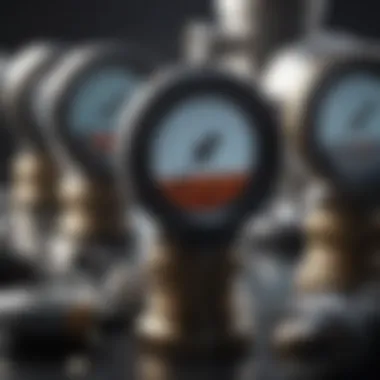
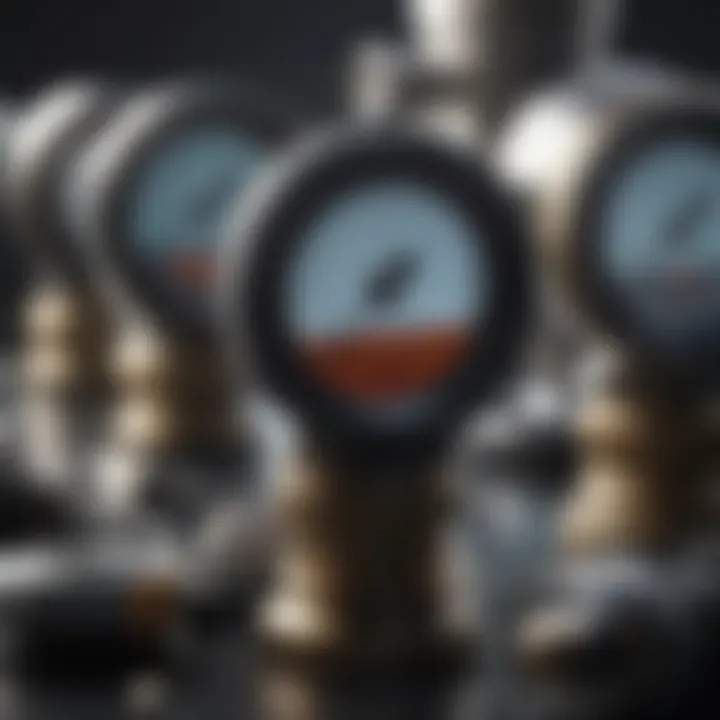
Furthermore, the specific types of solutes present can also matter. Different substances interact with light differently, affecting the overall reading. Consequently, it's vital to maintain consistent and known concentrations for reliable outcomes during measurement. It's often useful to keep a reference sample on hand, as it allows for immediate cross-checking of any unexpected results.
Wavelength of Light
The wavelength of the light source utilized in a refractometer can have a pronounced impact on readings. Different wavelengths can yield differing refractive indices for the same solution, leading to variations in data interpretation. For example, light in the visible spectrum may interact differently with a liquid compared to infrared or ultraviolet light. This aspect is crucial for laboratories that switch light sources, as a lack of standardization could produce misleading results.
Moreover, when measuring colored or opaque liquids, it becomes even more significant to ensure that the chosen wavelength can penetrate adequately to provide an accurate reading. To mitigate discrepancies, many modern refractometers are designed to operate at standardized wavelengths, aiding in consistency and reliability across measurements.
In summary, a comprehensive understanding of these factors—temperature variations, solute concentration, and light wavelength—can make all the difference in obtaining accurate and reproducible refractive index readings. Recognition of these variables not only enhances the reliability of measurements but genuinely underscores the importance of refractometry in fields ranging from gemology to food science.
"Precision in measurement is not merely a luxury; it’s the backbone of reliability across various applications, whether in identifying gemstones or ensuring food quality."
By factoring in these considerations, professionals can better navigate the complexities of liquid analysis and ultimately enhance the quality of their work.
Applications in Gemology
Refractometers hold a crucial place in the field of gemology, acting as a bridge connecting the scientific with the aesthetic. By measuring the refractive index of gemstones, these instruments help gemologists distinguish between different types of stones, assess their quality, and ultimately contribute to informed buying and selling choices. Understanding how refractometers play a role in gemology is key for enthusiasts and professionals alike. Their functionality can make the difference in ensuring authenticity, value, and overall satisfaction in gemstone dealings.
Identifying Gemstone Types
When it comes to identifying gemstones, refractometers are invaluable. Each type of gemstone has a specific refractive index, which is a distinctive fingerprint that can separate them from others. For instance, a skilled gemologist might use a refractometer to check the refractive index of a suspected sapphire, which usually ranges from 1.76 to 1.78.
In practice, when you place a gemstone on the refractometer's prism and observe the reading, it tells you more than just a number. If that reading fits within the expected range for sapphires, it’s a step towards confirming its identity. But if the number falls outside this range, it may indicate a different stone or even a synthetic version.
Furthermore, this precise identification mitigates the risk of fraud, a significant concern in the gemstone trade. Thus, refractometers go beyond being mere tools; they serve as instruments of trust and validation in an otherwise murky marketplace.
Assessing Gemstone Quality
Quality assessment is another critical application of refractometers in gemology. The refractive index not only aids in identification but also offers insights into a gemstone's clarity and brilliance. Higher quality stones tend to have a refractive index that meets certain thresholds based on their type.
Consider how light interacts with a gemstone. When light enters a stone and is refracted, it contributes to the overall appearance of the gem. A refractometer can help gemologists gauge whether a stone’s proportions and clarity align with its expected performance. For example, a well-cut diamond will usually present a certain refractive index range, enhancing its fire and scintillation.
"In gemology, the refractive index is the linchpin that connects beauty to authenticity."
Assessing a gemstone's quality using this single measurement might seem limited, but coupled with other factors—like color, cut, and clarity—it becomes a comprehensive analysis. This multipronged approach assists retailers in pricing gems accurately and allows collectors to understand the value of their investments.
Applications in Food and Beverage Industry
The food and beverage industry rely heavily on precision in measurements to ensure quality, safety, and consistency in products. This is where refractometers come into the picture—these handy devices serve as essential tools for assessing the characteristics of various liquids, especially in processes like brewing, winemaking, and even syrup production. Understanding how refractometers function in this realm not only illustrates their importance but also highlights their versatility across varying applications.
Measuring Sugar Concentration in Liquids
One of the primary uses of refractometers in the food and beverage sector is measuring sugar concentration. This measurement, often referred to as Brix, directly correlates to sweetness and potential fermentation processes.
By using a refractometer, producers can efficiently determine the sugar levels in fruit juices, soft drinks, and syrups. The result? More consistent flavor profiles and a reduction in batches that either lack sweetness or are overtly sugary.
The Brix scale is a critical parameter for producers in the food industry; a precise measurement can mean the difference between a product that delights consumers and one that fails to meet expectations.
Moreover, knowing the sugar concentration assists not only in formulation but also in monitoring fermentation progress during the production of alcoholic beverages. A quick reading can signify when yeast is consuming sugar efficiently, aiding brewers and vintners in decision-making processes.
Another advantage of incorporating refractometers in measuring sugar concentration is, they save time. Compared to traditional methods, these devices provide instantaneous results, allowing manufacturers to adjust their mixture rapidly, which can streamline operations significantly.
Quality Control in Brewing and Winemaking
In the brewing and winemaking arenas, quality control is paramount. Refractometers play a crucial role in ensuring the end product meets specified standards. For brewers, tracking the gravity of the wort—essentially the concentration of dissolved sugars before fermentation—is vital. The refractometer readings allow adjustments to be made early on, which can result in more successful fermentation.
For winemakers, monitoring sugar levels at various fermentation stages using a refractometer can ensure that the wine achieves the desired alcohol content and flavor profile. If the sugar concentration reads higher than anticipated, adjustments with acid or water can be made to maintain balance and avoid potential fermentation mishaps.
Ultimately, the use of refractometers in both brewing and winemaking translates to better quality products. By allowing for strict adherence to desired specifications, these instruments ensure that producers consistently deliver beverages that resonate with consumers.
In summary, the importance of refractometers in these applications is undeniable. Their ability to provide rapid, precise measurements empowers producers to maintain standards that sustain industry viability.
Maintenance of Refractometers
Proper maintenance of refractometers is crucial to ensure accuracy and reliability in liquid analysis. Given that these instruments are often used in critical applications such as gemology and food quality control, even minor lapses in their upkeep can lead to significant errors in readings. Regular maintenance not only prolongs the life of the refractometer but also enhances its performance, ensuring that the measurements remain precise and trustworthy.
Cleaning Procedures
Cleaning a refractometer is not just about appearance; it directly influences the accuracy of the readings. Build-up of residue, dust, or fingerprints on the prism and lens can distort light and lead to misleading results. Here’s a suggested cleaning routine:
- Daily Cleaning: After each use, gently wipe the prism surface using a soft, lint-free cloth or lens tissue. Avoid using rough materials that could scratch the glass.
- Regular Deep Cleaning: At least once a month, if the refractometer sees heavy use, you should carry out a deep clean. Use a mild detergent solution to soak the prism area, followed by thorough rinsing with distilled water. Ensure all residual cleaning agents are removed.
- Storage Considerations: Always store the device in a dust-free case when not in use to prevent environmental contaminants.


Calibration Techniques
Calibration is the soul of refractometry. An uncalibrated instrument can throw readings into disarray, leading professionals down the wrong path. Here’s an outline for effective calibration:
- Using Known Standards: Start with a set of standard liquids with known refractive indices. Water is commonly used (RI = 1.333) as one of the reference points.
- Temperature Control: Ensure that the temperature of the liquids matches the calibration settings; refractive index can fluctuate based on thermal variations.
- Adjustment Process: Follow the manufacturer’s instructions to adjust the scale to align with the known values. This might include using trimmer screws or electronic settings.
- Regularly Schedule Calibration: For high-accuracy environments, recalibrating before critical uses is wise. Instrument drift can occur, and catching this in a timely manner is paramount.
"Regular maintenance not only protects the instrument but also safeguards the integrity of your analysis."
In summary, the maintenance of refractometers consists of diligent cleaning and proper calibration, both essential elements that contribute to the precision in measurements across various applications. These procedures might seem minor, yet their impact is profound, ensuring the device remains a reliable ally in your analytical endeavors.
Challenges and Limitations
Understanding the challenges and limitations of refractometers is crucial for gemology professionals and hobbyists alike. It’s one thing to have the right tool in hand; it's another to wield it effectively, fully aware of the conditions that might skew results. This section is dedicated to shedding light on two significant hurdles—interference from impurities and accuracy issues at extreme temperatures. Both elements play a critical role in ensuring reliable measurements, affirming the importance of thorough knowledge in refractometry practices.
Interference from Impurities
In the world of liquid analysis, even the tiniest contaminant can throw a wrench into the works. Impurities may come from various sources—be it dust, residual chemicals, or unintended admixtures. When measuring the refractive index, these extraneous materials can lead to readings that are off the mark.
Consider the example of a refractometer used in a laboratory to measure a sugar-water solution. If there's any oil or dirt on the prism, the light path becomes altered, generating inaccurate results. To a gemstone analyst, the stakes can get pretty high! Misinformation could mislead gem quality assessments, potentially affecting sales or purchases.
To mitigate this issue, rigorous cleaning protocols need to be adhered to. Regular inspections for clarity in the refracting surfaces are essential. It's also wise to perform readings using a known standard solution before diving into new samples. This precaution serves as a baseline, helping detect any deviations caused by impurities.
"Purity ensures precision; clarity brings confidence."
Accuracy Issues at Extreme Temperatures
Another noteworthy limitation worth discussing is how temperature fluctuations can impact the accuracy of refractometric readings. Refractometers function on principles reliant on the refractive index, which can shift even slightly with temperature changes. This becomes a pressing concern in situations where temperature isn't controlled—imagine testing gemstones outdoors on a hot summer's day or the click of freezing air at high altitudes.
For example, a digital refractometer may give different readings at 30 degrees Celsius compared to readings at 10 degrees Celsius, even for the same liquid. This could mislead gemstone enthusiasts engaged in detailed quality control checks if they’re unaware of the influence temperature can wield.
To avoid this pitfall, it’s crucial to calibrate the refractometer at the temperature at which it’s going to be used. Many advanced refractometers helpfully include built-in temperature compensation features, which offers some relief. Yet, even with such tools, operators should monitor conditions closely, ensuring they understand how environmental factors could lead to discrepancies in their findings.
In summary, being aware of these challenges allows gemologists and analysts to take proactive measures, ensuring that their refractometric measurements remain as accurate and reliable as possible. The significance of refining these practices cannot be overstated, as they form the bedrock of qualitative assessment in gemstone analysis.
Future Trends in Refractometry
As we look forward, the realm of refractometry is not static; it's an evolving landscape that reflects broader advancements in technology and data processing. This section will illuminate the critical future trends shaping refractometry, underscoring their significance for those invested in precision measurement, particularly in fields like gemology and the food industry.
Technological Innovations
The push for technological improvements in refractometers is undeniable. It’s not just about better accuracy anymore; it’s also about the user experience and operational convenience.
Modern refractometers are becoming increasingly portable and versatile, paving the way for field applications. With the rise of miniaturized sensors and smart technologies, we see devices that not only capture refractive indexes but also provide supplementary data on temperature and concentration.
For example, Bluetooth-enabled refractometers now allow users to sync data with mobile devices. This feature means that gem collectors can capture real-time readings while on the go and store them in easily accessible digital formats. Such advancements not only enhance functionality but also contribute to data integrity through automatic logging and reduced human error.
Another exciting development is the incorporation of artificial intelligence. With AI algorithms, refractometers can analyze readings against vast databases of material characteristics. This means that users can receive not only the refractive index but also hints and insights into the nature of the liquid being tested. If a gemstone collector is unsure of the stone type, advanced refractometers could offer suggestions based on its properties decoded through machine learning.
Integration with Data Analytics
Today’s economy thrives on data, and refractometry is no exception. The integration of data analytics is ushering in a new era of precision and decision-making. Refractometers, when combined with analytics tools, can provide far more than mere readings. They offer a comprehensive insight into trends and patterns.
Consider the food and beverage industry, where maintaining quality and compliance is paramount. By leveraging data analytics, producers can track refractive indices across batches. This fosters not only real-time quality control but also predictive analytics that warn of deviations before they escalate into significant issues.
Moreover, in the context of gemology, integrating data from different sources can create a robust database. Collectors and jewelers are able to visualize trends in gemstone quality based on refractive index comparisons, leading to more informed purchases and sales decisions.
The future isn’t just about collecting data but making it meaningful. Through dashboards and visual analytics, users can derive actionable insights from raw data points, fostering a more informed and analytical approach to liquid analysis.
"As refractometry adapts to technological advancements, it holds potential that transcends traditional boundaries, guiding industry professionals with precision and insightful data."
As we glance ahead, it's evident that refractometry is on the verge of transformative growth. With technological advancements and data-driven approaches, it’s poised to become an indispensable tool across various industries. The evolution of these instruments promises not just enhanced functionality but also a deeper understanding of the liquids under scrutiny, making refractometers essential for gem enthusiasts and quality-conscious producers alike.
Epilogue
The field of refractometry is not just about taking measurements; it's about understanding the intersection of science and technology in liquid analysis. Refractometers serve as critical tools across various sectors, whether it’s gemology, food and beverage, or even pharmaceuticals. Their ability to provide quick, reliable data on the refractive index helps industries maintain standards and ensures product consistency.
Summary of Key Insights
Throughout this article, we’ve uncovered several key insights regarding the functionality and significance of refractometers:
- Precision Measurement: Refractometers empower users to make accurate assessments, reflecting changes in concentration and quality swiftly. This demand for precision is strong in the jewelry industry, where gem classification relies heavily on accurate indices.
- Variety of Applications: It's clear that these instruments aren’t confined to a single industry. From measuring sugar content in liquids to identifying gemstones, the diverse applications highlight their versatility.
- Technological Progress: With advances in digital refractometers and data analytics, the future looks bright. These innovations promise improved accuracy and richer data outputs, supporting professionals in making informed decisions.
- Importance of Maintenance: Regular maintenance and calibration are pivotal to sustaining the functionality of any refractometer. Keeping the device clean and adhering to recommended standards ensures longevity.
Final Remarks on Importance of Refractometry
To wrap it up, refractometry stands as a vital component of quality control and analysis across multiple domains. The significance of accurately measuring refractive indices can't be overstated. In industries ranging from gemology to the food sector, the right measurements can prevent costly mistakes, validate product integrity, and contribute to thorough quality assessments.
The journey of exploring refractometers paints a picture of scientific precision at its finest. For enthusiasts and professionals alike, understanding this tool contributes to greater insight and rigorous analysis, making it an indispensable aspect of liquid measurement today.







